Physical Address
304 North Cardinal St.
Dorchester Center, MA 02124
This chapter will cover primarily those entities that come to the attention of the surgical pathologist; therefore most non-neoplastic entities of the intraocular tissues will be excluded. Dystrophies and degenerative conditions of the cornea also represent a complex subject which will not be covered here. For a more detailed description of these and other diseases, the reader is referred to one of the many specialized textbooks available. As with all surgical specimens, a complete description of the lesion and a meaningful clinical history are invaluable. Clinical photographs are especially helpful in ophthalmic pathology.
The eyelids are divided into a cutaneous and a conjunctival portion. The former is composed of stratified squamous epithelium and the latter of a much thinner conjunctival epithelium. In addition to standard pilosebaceous units, skin appendages of eyelids include sebaceous glands of Zeis, apocrine glands of Moll, and eccrine sweat glands, as well as the large sebaceous meibomian glands embedded in the thick fibrocellular tarsal plate.
The lacrimal gland is largely of serous type, with a minor mucinous component in the ductal portion and a layer of myoepithelial cells in the larger peripheral ducts. In addition to the main lacrimal gland in the orbit, accessary lacrimal glands of Wolfring and Krause are present at the base of the tarsal plate and conjunctival fornix, respectively. The lacrimal passages allow tears produced by the lacrimal gland to be transported from the eye into the nasal cavity . Tears enter from the ocular surface into upper or lower punctum and drain through the canaliculus into the lacrimal sac and then the nasolacrimal duct , which opens in the nasal cavity. The canaliculus is lined by stratified, nonkeratinized epithelium, while both the lacrimal sac and the nasolacrimal duct are lined by stratified columnar epithelium containing mucus-secreting goblet cells.
The orbit contains, in addition to the ocular globe and the lacrimal gland, the following structures: the optic nerve and its meningeal covering, Tenon's capsule, the extraocular muscles, blood vessels, and a delicate framework of fibroadipose connective tissue.
The conjunctiva is a thin mucous membrane that lines the inner surface of the eyelids and most of the anterior surface of the ocular globe. The conjunctival epithelium is composed of two to five layers of columnar cells that rest on a continuous basal lamina. This epithelium contains mucin-secreting goblet cells and melanocytes.
The caruncle is a small, fleshy protuberance that fills the triangular space between the medial margins of the upper and lower eyelids. It is covered by epithelium similar to conjunctiva, but contains pilosebaceous units and sweat glands.
The cornea consists of six distinct layers: epithelium, epithelial basal lamina, Bowman layer (an acellular structure made up of collagen fibers, which cannot regenerate), stroma, Descemet membrane (a basal lamina produced by the underlying corneal endothelial cells), and a single layer of very flat cells known as “endothelium,” but not related to vascular endothelium. A region of epithelial progenitors known as the limbus surrounds the cornea.
The thick sclera encloses the globe and is mainly composed of a dense collagenous stroma admixed with occasional elastic fibers and scattered fibroblasts.
The intraocular tissues comprise the uveal tract (iris, ciliary body, and choroid), the retinal pigment epithelium, the retina, the crystalline lens, and the various intraocular compartments. A detailed description of these structures and how they age is beyond the scope of this book but has recently been reviewed.
Most of the pathologic processes that involve the eyelids are those that affect the skin in general and are considered in detail in Chapters 2 and 3 . Some consideration, however, is given in this chapter to those lesions that are either peculiar to the lids or present particular problems in this location.
Dermoid cysts typically involve the upper eyelid along the lateral brow margin, where ectoderm becomes entrapped during embryologic bony fusion, and often represent forward extension of a mass that is primarily intraorbital ( Fig. 45.1 ). Microscopically, the cysts are lined by well-differentiated epidermal and dermal tissues containing all of the usual skin appendages. The lumen is filled with keratinous debris, sebum, and hairs. In places where these contents have been extruded into the surrounding tissues, a severe foreign body inflammatory reaction may be observed ( Fig. 45.2 ).
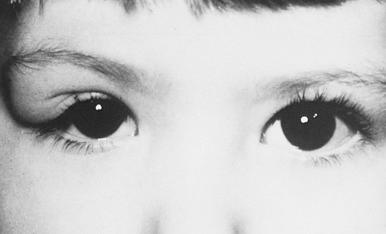
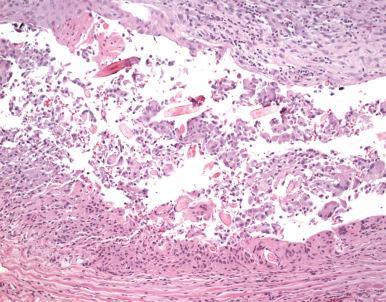
Inflammation of the eyelids (blepharitis) may be the result of viral, bacterial, rickettsial, mycotic, or parasitic infections; chemical or physical irritants; hypersensitivity states; or systemic dermatologic disorders. These inflammatory processes are rarely biopsied. Eversion or sagging of the eyelid, known as ectropion , is often corrected surgically and results in specimens showing conjunctival goblet cell loss and squamous metaplasia ( Fig. 45.3 ).
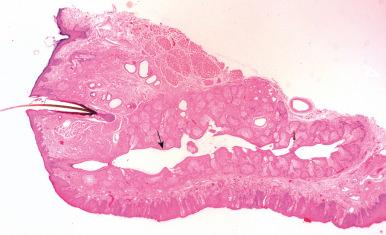
Granuloma annulare (Pseudorheumatoid nodule) can occasionally involve the eyelid and eyebrow and rarely the episcleral and orbital tissues; it generally presents in children and young adults.
Necrobiotic xanthogranuloma with paraproteinemia is characterized by multiple nodules or plaques that involve the periorbital areas (including eyelids) along with other parts of the body. A dysproteinemia is frequently present, and the lesions can also be associated with multiple myeloma. Microscopically, the granulomas are characterized by collagen “necrobiosis” together with foamy macrophages and Touton giant cells.
Chalazion is an extremely common lesion. It represents a lipogranuloma that develops in and about a meibomian gland as a consequence of the effects of obstruction. The sebaceous material discharged into the tarsus provokes an intense granulomatous inflammatory reaction ( Fig. 45.4 ).
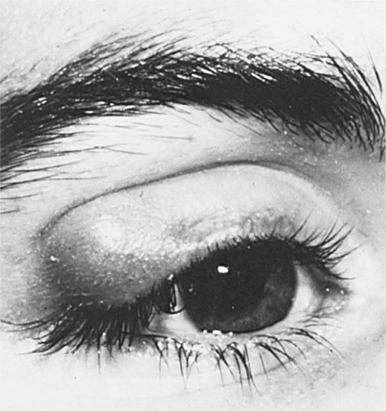
Although chalazion begins as a deep-seated process, not infrequently it erupts through the conjunctival surface of the eyelid and can be associated with an overlying pyogenic granuloma. Ordinarily, this lesion is readily recognized and treated; however, if one or more recurrences develop after curettage, sebaceous carcinoma arising from the meibomian gland or other neoplasm must be ruled out.
Microscopically, the typical chalazion reveals multiple foci of granulomatous inflammation ( Fig. 45.5 ). In the center of many of the granulomas there are small globules of fat, which in paraffin sections present as empty, round to ovoid spaces.
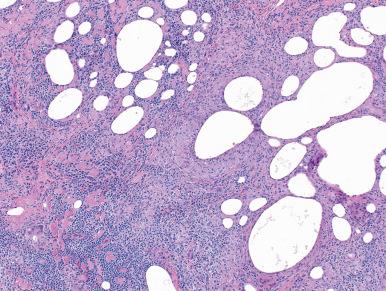
Benign cysts of the skin of the eyelids and along the lid margins are relatively common, comprising approximately one-third of lesions removed from the lids. The most common of these are the keratinous cysts discussed in Chapter 3 . Keratinizing intratarsal Meibomian gland cysts have recently been described, which arise from ductal epithelium and, in contrast to cutaneous keratinous cysts, are positive for keratin 17 and carcinoembryonic antigen (CEA).
Cysts arising from blocked sweat glands are common in the periocular region and are known as sudoriferous cysts or hidrocystoma. They are filled with a watery fluid and can be multilocular ( Fig. 45.6 ). Apocrine and eccrine hidrocystoma are differentiated by the tall apical epithelial snouts and “decapitation” secretion in the former, and flatter epithelial profiles in the latter. In one institutional series of 5504 eyelid cases, hidrocystomas represented 8% of all benign lesions.
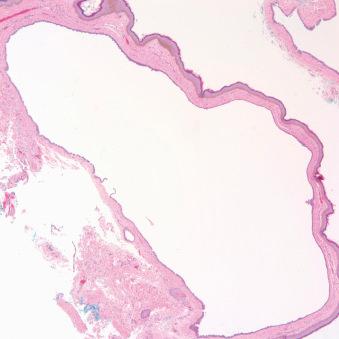
Basal cell carcinoma is by far the most frequent neoplasm arising in any of the palpebral tissues. The overwhelming majority are easily excised without sequelae. On rare occasions, if left untreated for long periods, they may invade the orbit, nose, or both, and exenteration of the orbit may become necessary. Microscopic examination of the margins by frozen section at the time of surgery is a useful technique for ensuring that total removal of the tumor has been achieved.
Basal cell carcinomas arise from the cutaneous surface of the eyelids and rarely, if ever, from the conjunctiva. This point is of some diagnostic significance, for a papilloma of the palpebral conjunctiva, or more ominously a sebaceous carcinoma involving the conjunctiva and lid margin, may resemble basal cell carcinoma.
Squamous cell carcinoma is responsible for 4%–12% of all malignant epithelial tumors of the eyelid. Most cases are located in the lower lid. A small percentage of these tumors are of the adenoid (pseudoglandular or acantholytic) type. Clear cell or vesicular change can also be seen in squamous carcinoma and can mimic sebaceous carcinoma. Vacuolar adipophilin expression is useful in distinguishing sebaceous carcinoma from basal or squamous cell carcinoma.
Merkel cell carcinoma can occur in the eyelid, its morphologic appearance being the same as elsewhere in the skin. Most reported cases have been located in the upper eyelid, where they have presented as a large, nontender, red, or violaceous mass.
Non-neoplastic keratotic lesions may closely resemble squamous cell carcinomas. They include such entities as papilloma, pseudoepitheliomatous hyperplasia, keratoacanthoma, inverted follicular keratosis, irritated seborrheic keratosis, actinic keratosis, and cutaneous horns. The histopathologic features of these lesions are described in Chapter 3 .
Sebaceous adenomas and carcinomas may arise from the cutaneous sebaceous glands, the glands of Zeis, or the meibomian glands ( Fig. 45.7 ). They seem to be more common in Asian countries. Muir–Torre syndrome should be considered when sebaceous adenomas or carcinomas are diagnosed around the eye, but the association at this site is not as strong as elsewhere on the skin. Some of these carcinomas have been seen as a second malignancy following radiation therapy for retinoblastoma (RB). Periocular sebaceous carcinomas can clinically mimic a range of conditions and are not infrequently misdiagnosed as squamous cell or basal cell carcinomas.
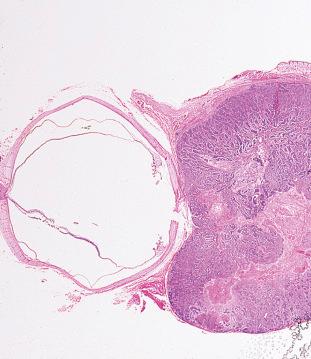
Solitary adenomas of the meibomian and Zeis glands are rarely seen. Indeed, while sebaceous carcinomas can show considerable histologic variation, in the eyelid they tend to be more poorly differentiated that at other cutaneous sites ( Fig. 45.8 ). DNA mismatch repair defects are less common in sebaceous neoplasms arising in the eyelid than elsewhere on the skin.
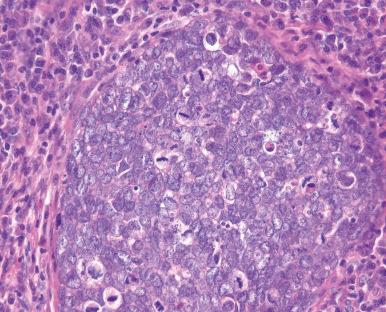
The most common presentation of sebaceous carcinoma in the eyelid is as round highly cellular nests of poorly differentiated tumor cells in the dermis, sometimes with central necrosis in a comedocarcinoma pattern (see Fig. 45.8 ). While better-differentiated cells with vacuolated cytoplasm can sometimes be identified, they are generally rare and sometimes completely absent. In such situations immunostains for adipophilin have been used to document sebaceous differentiation. EMA immunostains are generally less useful, as they only highlight well-differentiated sebaceous cells. Oil red O stains for fat can also be helpful but are limited to frozen sections.
Additional valuable clues to the diagnosis can be found in the pattern of tumor dissemination, as intraepithelial spread through the conjunctiva is quite common, and is not seen in basal cell carcinoma ( Fig. 45.9 ). Indeed, sometimes intraepithelial sebaceous carcinoma is encountered in the conjunctiva in the absence of a clear subepithelial tumor mass. This is sometimes referred to as “ in situ ” sebaceous carcinoma, although it is not clear if this represents a true primary conjunctival lesion or spread from an occult site. Pagetoid involvement of the overlying skin can also occur, resulting in a clinical picture of chronic blepharoconjunctivitis, sometimes with no clear mass lesion present.
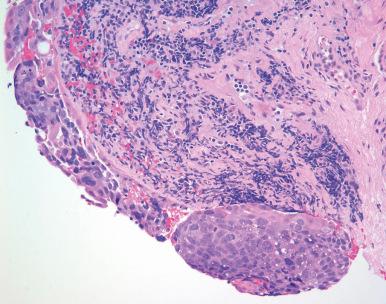
In the series of sebaceous carcinoma by Rao et al., 23 out of 104 patients died from metastatic disease, confirming the fact that sebaceous carcinoma is a more aggressive neoplasm when located in the ocular adnexa. Features indicative of a poor prognosis were orbital or vascular invasion, involvement of both eyelids, poor differentiation, multicentric origin, large size, a highly infiltrative pattern, and pagetoid spread. Mapping biopsies from multiple sites on the eyelid and ocular surface are sometime taken prior to definitive excision of a sebaceous carcinoma; p16 and p53 immunostains can be useful in highlighting intraepithelial tumor cells in these situations.
Endocrine mucin-producing sweat gland carcinoma (EMPSGC) of the eyelid is composed of bland, round to oval cells with variably solid, cystic, and papillary growth patterns ( Fig. 45.10 ). These lesions are distinctive due to their focal expression of EMA and neuroendocrine markers such as synaptophysin and chromogranin, in conjunction with mucin production ( Fig. 45.11 ). They appear to represent a precursor of invasive mucinous carcinoma of skin, which can also present around the eye. Diffuse expression of cytokeratin 7, CEA, estrogen receptor proteins, and other apocrine markers is common and can be useful in distinguishing EMPSGC from other sweat gland tumors. While local recurrence is not uncommon, this group of tumors rarely metastasize or prove fatal, and expression of neuroendocrine markers does not appear to be of prognostic significance.
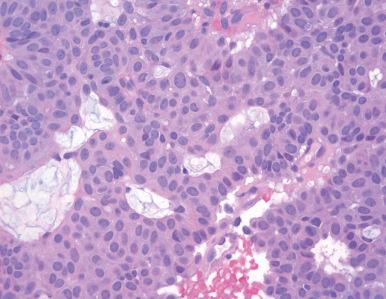
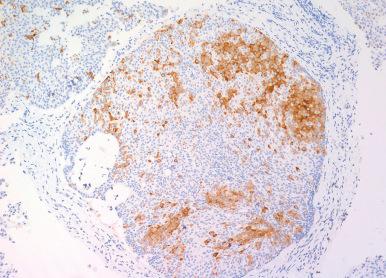
Signet ring/histiocytoid carcinomas morphologically similar to those seen at other sites can arise in the eyelid. Before making the diagnosis of a primary tumor, the possibility of a metastasis from the breast or other organs needs to be ruled out.
Melanocytic nevi may be observed in either the cutaneous or the conjunctival surface of the eyelids. The lid margin is a particularly common site, and the divided or “kissing” nevus is a rare but developmentally interesting variant. Most nevi are of the junctional or compound type, but all variants can be encountered at this site, including nevi associated with the Meibomian gland ( Fig. 45.12 ). A more diffuse and deeply situated melanotic lesion of the lids thought to be related to incomplete melanocyte precursor migration is the nevus of Ota (congenital oculodermal melanosis). This is a form of extrasacral mongolian spot involving the face in areas supplied by the first and second branches of the trigeminal nerve. This type of nevus occurs more frequently in Asians and blacks than in whites. It is associated with an increased incidence of melanoma and melanocytoma of the eyes, orbit and meninges, with GNAQ mutations identified in malignant lesions. Melanosis oculi is a related congenital anomaly characterized by variable hyperpigmentation of the conjunctiva, episclera, sclera, uveal tract, and, occasionally, the optic nerve. Patients with this disorder have an increased incidence of ocular malignant melanoma. So-called acquired melanosis is a disorder that may involve either surface or both surfaces of the eyelid in association with the conjunctiva and is described in the section on the conjunctiva.

Melanoma of the eyelid is rare. It may originate from a nevus that has been present for many years, from an acquired melanosis of variable duration, or de novo. Nodal metastasis at presentation has been significantly correlated with American Joint Committee on Cancer T category and time to local recurrence or metastasis.
The morphologic appearances and diagnostic problems presented by these lesions when located in the eyelid are largely similar to those of analogous lesions of the skin, conjunctiva, and orbit; the latter are fully discussed later in this chapter. The only differences of note are that the percentage of malignant tumors seems to be higher for lymphoid masses in the eyelid than for those in the other sites, and that the eyelids seem to be the preferential site of involvement for the rare anaplastic large cell lymphoma of the ocular region.
Angiomas may present as small lesions confined to the eyelid or extend deep into the orbit. Hemangiomas are more common than lymphangiomas. Their histopathologic characteristics are described in Chapter 3 .
The so-called port-wine stain (nevus flammeus) is of special interest not only because of its significant cosmetic effect, but also because it may be associated with malformations in other tissues. In the Sturge–Weber syndrome , the facial hemangioma may be associated with choroidal hemangioma, glaucoma, and meningeal hemangioma, all on the ipsilateral side ( Fig. 45.13 ).

Masson hemangioma (intravascular papillary endothelial hyperplasia) can develop in the eyelid, either de novo or engrafted on a preexisting vascular lesion. Hemangiopericytoma also occurs in the eyelid and orbit, the current interpretation being that it represents a solitary fibrous tumor with a hemangiopericytoma-like pattern of growth. Cases have also been reported of epithelioid hemangioendothelioma. and myoepithelioma .
Neurofibromas can present as isolated lesions or as a component of von Recklinghausen disease. Although believed to be present from birth, these tumors frequently show accelerated growth during childhood or later. PEComas (perivascular epithelioid cell tumors) can exceptionally involve the eyelid.
Xanthelasmas are slightly elevated yellow plaques located on the medial aspect of the upper and lower eyelids ( Fig. 45.14 ). They are rarely indicative of any serious systemic disturbance and are usually removed for cosmetic reasons. Most of the patients are in the fifth or sixth decade of life. Patients with familial hypercholesterolemia may develop these lesions at a younger age. Microscopically, these lesions show large, pale-staining, fat-laden histiocytes throughout the subepithelial tissues ( Fig. 45.15 ). If atypia is present, the possibility of primary or metastatic histiocytoid carcinoma should be considered.
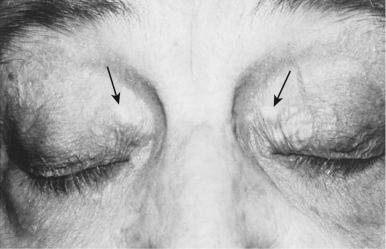
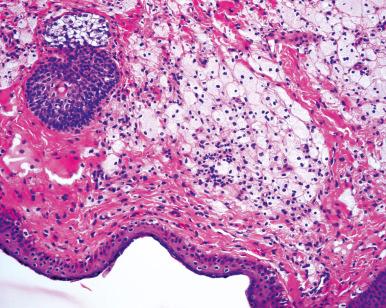
Amyloidosis can occur in the eyelid and conjunctiva as a localized mass. It presents as a chronic painless mass, usually not associated with any systemic disease, although myeloma and related conditions can be present.
Carcinomas from various sites can metastasize to one or both eyelids, sometimes as the first manifestation of the disease. A notorious diagnostic trap in this area is the mammary lobular carcinoma having striking histiocytoid features and simulating an inflammatory process ( Fig. 45.16 ).
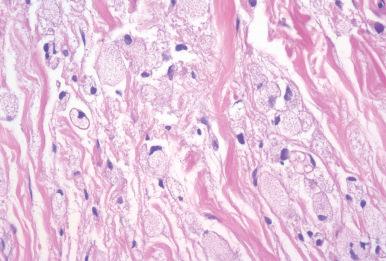
While most lacrimal gland lesions are orbital, they can extend into the eyelid or arise from accessory lacrimal glands in the eyelid base. Lacrimal gland lesions are divided into nonepithelial and epithelial groups. Among the epithelial tumors, benign mixed cell tumor (pleomorphic adenoma) is the most common. The nonepithelial lesions, which make up over half of the cases, include inflammatory pseudotumor, lymphoid hyperplasia, nonspecific dacryoadenitis, sarcoidosis, Mikulicz disease, Sjögren syndrome, and lymphoma. Nonspecific chronic dacryoadenitis, comprised of patchy or diffuse lymphoplasmacytic infiltrates, is the type the pathologist sees most frequently. However, some specific systemic conditions should be considered.
When chronic dacryoadenitis is associated with enlargement of the parotid or other salivary glands, it has been referred to as Mikulicz syndrome . This may be the result of a variety of specific diseases, including sarcoidosis, tuberculosis, syphilis, mumps, Graves disease, malignant lymphoma, and leukemia, or associated with lymphocytic infiltration and formation of lymphoepithelial lesions historically known as Mikulicz disease. Increased numbers of IgG4-expressing plasma cells are generally found in Mikulicz disease, and it is now thought to represent part of the IgG4-related disease spectrum.
This chronic autoimmune syndrome occurs most frequently in middle-aged women. Mononuclear cell aggregates are found around the ducts and acini of salivary, lacrimal, and labial glands and result in oral and ocular dryness. However, specific inflammatory cell thresholds of the type used in labial salivary gland biopsy do not exist for lacrimal glands, making it difficult to establish a firm diagnosis based on periocular biopsies.
Most neoplasms of the lacrimal gland arise in the orbital lobe, where the gland is firmly attached to the orbital rim about the lacrimal fossa. The bone tends to restrict growth in its direction; hence, the enlarging tumor characteristically displaces the eye downward and nasally. A recent study of 702 malignant tumors of the lacrimal gland in the Surveillance, Epidemiology, and End Results (SEER) database identified lymphoma (58%), adenoid cystic carcinoma (13%), adenocarcinoma (4%), and mucoepidermoid carcinoma (4%) as the most common entities.
Epithelial tumors have, on the whole, histopathologic, ultrastructural, and immunohistochemical features very similar to those of the salivary glands (see Chapter 6 ). Benign mixed tumors (pleomorphic adenomas) account for approximately 50%–60%, malignant mixed tumors (carcinomas ex-pleomorphic adenomas) for 5%–10%, adenoid cystic carcinomas for 20%–30%, and other carcinomas for 5%–10%. Many of the mixed tumors have a predominant component of hyaline cells of presumed myoepithelial nature ( Fig. 45.17 ). Oncocytomas , epithelial–myoepithelial carcinomas , and myoepithelial carcinomas have also been reported. The carcinomas have a poor prognosis overall, although earlier detection and complete excision has resulted in some long-term survivors.
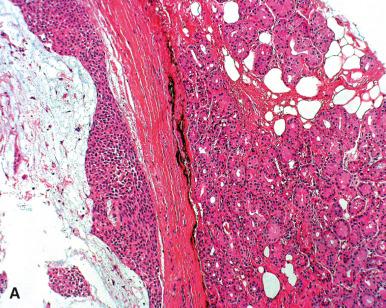
The appearance of an invasive squamous cell carcinoma of the lacrimal gland can be simulated by necrotizing sialometaplasia , in a manner akin to that seen with greater frequency in minor (and sometimes major) salivary glands.
Lymphoid tumors and tumorlike conditions (malignant lymphomas, lymphoid hyperplasias, and chronic inflammatory processes) are important causes of enlargement of the gland. In one orbital series including 114 lacrimal gland lesions, 55% were nonepithelial, with nonspecific chronic dacryoadenitis being most common, followed by malignant lymphoma and reactive lymphoid hyperplasia. Chronic dacryoadenitis, particularly when it is associated with sclerosis, may be part of the spectrum of IgG4-related diseases. However, most cases of mild dacryoadenitis lack increased numbers of IgG4-positive cells. Lymphomas of the lacrimal gland are most often MALT or other low-grade B-cell neoplasms; however, more aggressive forms such as mantle cell lymphoma and diffuse large B-cell lymphoma can present at this site as well ( Fig. 45.18 ).
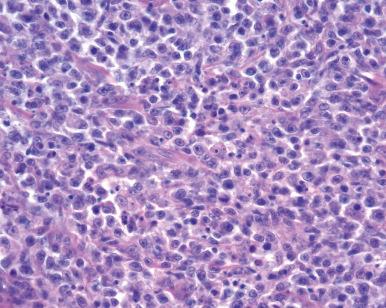
Mesenchymal tumors of the lacrimal gland are exceptional. They comprise a few case reports of solitary fibrous tumor, giant cell angiofibroma (a morphologic variant of solitary fibrous tumor), collagenous fibroma (desmoplastic fibroblastoma), and granular cell tumor.
Diseases of the lacrimal passages that are of importance to the surgical pathologist are characterized by epiphora (the imperfect drainage of tears so that they flow over the lid margin onto the cheek) and by varying degrees of swelling, induration, and inflammation of the lower eyelid at its nasal end. Although inflammatory obstructions of these passages are common, neoplastic lesions are relatively rare.
Canaliculitis and dacryocystitis may be the result of direct spread of inflammatory processes in neighboring structures such as the conjunctiva or nasal cavity, but more often their pathogenesis is obscure. Acute and chronic types are recognized, and the inflammatory reaction may be suppurative, granulomatous, or necrotizing, with the formation of fistulous tracts to the skin surface below the eyelid near the base of the nose.
The lacrimal passages become filled with purulent exudate in the acute suppurative types, whereas in the chronic forms the passages are narrowed by inflammatory thickening of the walls of the lacrimal canal or sac. Occasionally, there is hyperplasia of the lining epithelium and hypersecretion of mucus. At times, reactive hyperplasia of the sac may be difficult to distinguish squamous or transitional neoplasms.
Sarcoidosis may involve the lacrimal sac as an extension of upper respiratory tract disease.
Lacrimal mucocele is another complication of chronic inflammation of the lacrimal sac. A low-grade obstructive lesion with a relatively intact and possibly hypersecreting mucosa may lead to great distention of the sac by accumulated secretions.
The contents of the cyst may be clear or milky, fluid or gelatinous, fibrinous or flocculent, sterile or infected. Microscopically, the cyst wall reveals varying degrees of atrophy, degeneration, hyperplasia, hypersecretion of the mucosa, and chronic inflammation of the subepithelial tissues.
Become a Clinical Tree membership for Full access and enjoy Unlimited articles
If you are a member. Log in here